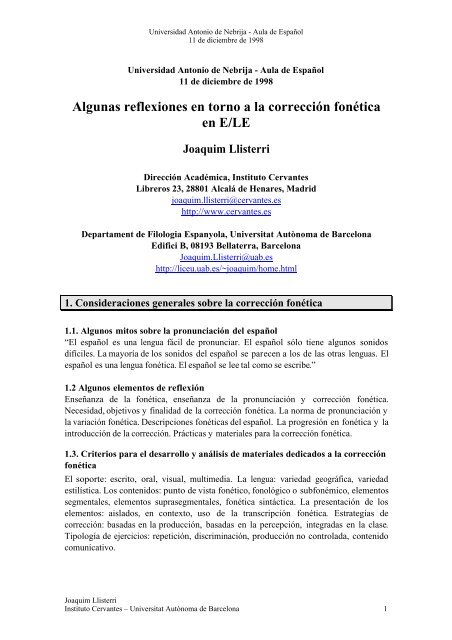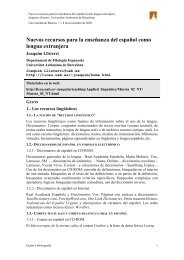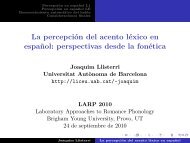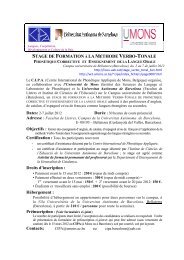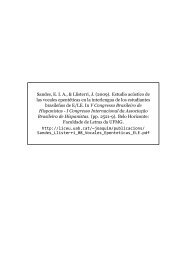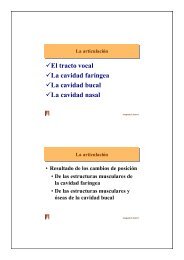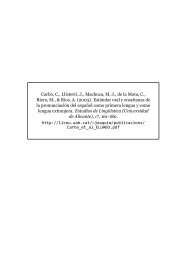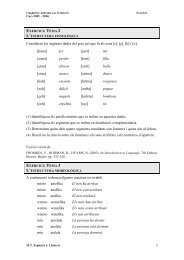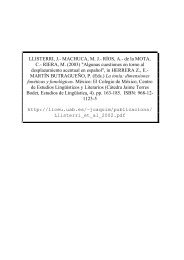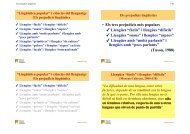Algunas reflexiones en torno a la corrección ... - ResearchGate
Algunas reflexiones en torno a la corrección ... - ResearchGate
Algunas reflexiones en torno a la corrección ... - ResearchGate
You also want an ePaper? Increase the reach of your titles
YUMPU automatically turns print PDFs into web optimized ePapers that Google loves.
Universidad Antonio de Nebrija - Au<strong>la</strong> de Español<br />
11 de diciembre de 1998<br />
Universidad Antonio de Nebrija - Au<strong>la</strong> de Español<br />
11 de diciembre de 1998<br />
<strong>Algunas</strong> <strong>reflexiones</strong> <strong>en</strong> <strong>torno</strong> a <strong>la</strong> corrección fonética<br />
<strong>en</strong> E/LE<br />
Joaquim Llisterri<br />
Dirección Académica, Instituto Cervantes<br />
Libreros 23, 28801 Alcalá de H<strong>en</strong>ares, Madrid<br />
joaquim.llisterri@cervantes.es<br />
http://www.cervantes.es<br />
Departam<strong>en</strong>t de Filologia Espanyo<strong>la</strong>, Universitat Autònoma de Barcelona<br />
Edifici B, 08193 Bel<strong>la</strong>terra, Barcelona<br />
Joaquim.Llisterri@uab.es<br />
http://liceu.uab.es/~joaquim/home.html<br />
1. Consideraciones g<strong>en</strong>erales sobre <strong>la</strong> corrección fonética<br />
1.1. Algunos mitos sobre <strong>la</strong> pronunciación del español<br />
“El español es una l<strong>en</strong>gua fácil de pronunciar. El español sólo ti<strong>en</strong>e algunos sonidos<br />
difíciles. La mayoría de los sonidos del español se parec<strong>en</strong> a los de <strong>la</strong>s otras l<strong>en</strong>guas. El<br />
español es una l<strong>en</strong>gua fonética. El español se lee tal como se escribe.”<br />
1.2 Algunos elem<strong>en</strong>tos de reflexión<br />
Enseñanza de <strong>la</strong> fonética, <strong>en</strong>señanza de <strong>la</strong> pronunciación y corrección fonética.<br />
Necesidad, objetivos y finalidad de <strong>la</strong> corrección fonética. La norma de pronunciación y<br />
<strong>la</strong> variación fonética. Descripciones fonéticas del español. La progresión <strong>en</strong> fonética y <strong>la</strong><br />
introducción de <strong>la</strong> corrección. Prácticas y materiales para <strong>la</strong> corrección fonética.<br />
1.3. Criterios para el desarrollo y análisis de materiales dedicados a <strong>la</strong> corrección<br />
fonética<br />
El soporte: escrito, oral, visual, multimedia. La l<strong>en</strong>gua: variedad geográfica, variedad<br />
estilística. Los cont<strong>en</strong>idos: punto de vista fonético, fonológico o subfonémico, elem<strong>en</strong>tos<br />
segm<strong>en</strong>tales, elem<strong>en</strong>tos suprasegm<strong>en</strong>tales, fonética sintáctica. La pres<strong>en</strong>tación de los<br />
elem<strong>en</strong>tos: ais<strong>la</strong>dos, <strong>en</strong> contexto, uso de <strong>la</strong> transcripción fonética. Estrategias de<br />
corrección: basadas <strong>en</strong> <strong>la</strong> producción, basadas <strong>en</strong> <strong>la</strong> percepción, integradas <strong>en</strong> <strong>la</strong> c<strong>la</strong>se.<br />
Tipología de ejercicios: repetición, discriminación, producción no contro<strong>la</strong>da, cont<strong>en</strong>ido<br />
comunicativo.<br />
Joaquim Llisterri<br />
Instituto Cervantes – Universitat Autònoma de Barcelona 1
Universidad Antonio de Nebrija - Au<strong>la</strong> de Español<br />
11 de diciembre de 1998<br />
1.4. Metodología de trabajo para el profesor<br />
P<strong>la</strong>nteami<strong>en</strong>to de objetivos: definición de <strong>la</strong> norma fonética; determinación del grado de<br />
precisión fonética <strong>en</strong> <strong>la</strong> producción. Estudio de <strong>la</strong> interl<strong>en</strong>gua. Análisis y jerarquización<br />
de errores. Establecimi<strong>en</strong>to de una progresión: prioridades <strong>en</strong> función de <strong>la</strong> L1del<br />
estudiante; contrastes fonológicos y contrastes fonéticos. Definición de estrategias de<br />
corrección. E<strong>la</strong>boración de ejercicios de corrección. Seguimi<strong>en</strong>to de los resultados.<br />
2. La fonética contrastiva<br />
2.1. Conceptos g<strong>en</strong>erales<br />
La fonética y <strong>la</strong> fonología <strong>en</strong> el marco del análisis contrastivo y de <strong>la</strong> lingüística<br />
estructural. El análisis contrastivo como método de explicación y de predicción de<br />
errores. Transfer<strong>en</strong>cia positiva y transfer<strong>en</strong>cia negativa. Comparación de inv<strong>en</strong>tarios<br />
segm<strong>en</strong>tales de <strong>la</strong> L1 y <strong>la</strong> L2.<br />
2.2. Utilidad y limitaciones de <strong>la</strong> fonética contrastiva como sistema de predicción<br />
de errores<br />
Difer<strong>en</strong>cias distribucionales <strong>en</strong>tre fonemas exist<strong>en</strong>tes <strong>en</strong> <strong>la</strong> L1 y <strong>la</strong> L2. Realización de<br />
fonemas condicionada por <strong>la</strong> fonética sintáctica. Difer<strong>en</strong>cias <strong>en</strong>tre reg<strong>la</strong>s fonotácticas de<br />
<strong>la</strong> L1 y <strong>la</strong> L2. Difer<strong>en</strong>te manifestación fonética de fonemas exist<strong>en</strong>tes <strong>en</strong> <strong>la</strong>s dos l<strong>en</strong>guas.<br />
Necesidad de una comparación <strong>en</strong> el nivel fonético.<br />
2.3. Similitudes y difer<strong>en</strong>cias <strong>en</strong>tre los sonidos de <strong>la</strong> L1 y <strong>la</strong> L2<br />
Sonidos nuevos <strong>en</strong> <strong>la</strong> L2: posibilidad de producción nativa. Sonidos simi<strong>la</strong>res <strong>en</strong> <strong>la</strong> L1 y<br />
<strong>la</strong> L2: producción no nativa debida a <strong>la</strong> interfer<strong>en</strong>cia. Sonidos idénticos <strong>en</strong> <strong>la</strong> L1 y <strong>la</strong> L2:<br />
producción nativa.<br />
3. Aproximaciones a <strong>la</strong> corrección fonética<br />
3.1. Métodos articu<strong>la</strong>torios<br />
Descripción y visualización de <strong>la</strong> posición del aparato fonatorio: el problema de <strong>la</strong><br />
propiocepción, <strong>la</strong> integración <strong>en</strong> <strong>la</strong> producción espontánea y <strong>la</strong>s limitaciones<br />
comunicativas.<br />
3.2. Métodos basados <strong>en</strong> <strong>la</strong> audición e imitación<br />
Los pares mínimos como ejemplificación de contrastes fonológicos: limitaciones<br />
auditivas y limitaciones comunicativas. Los <strong>la</strong>boratorios de idiomas y los ejercicios de<br />
pronunciación basados <strong>en</strong> <strong>la</strong> audición y <strong>la</strong> repetición: problemas <strong>en</strong> <strong>la</strong>s primeras etapas<br />
de <strong>la</strong> adquisición y limitaciones.<br />
3.3. El sistema verbo-tonal<br />
Integración de <strong>la</strong> corrección fonética <strong>en</strong> <strong>la</strong> c<strong>la</strong>se de l<strong>en</strong>gua. La hipótesis de <strong>la</strong> sordera<br />
fonológica y <strong>la</strong> modificación del comportami<strong>en</strong>to perceptivo del alumno. La importancia<br />
de <strong>la</strong> <strong>en</strong>tonación y el ritmo. Los procedimi<strong>en</strong>tos de corrección fonética <strong>en</strong> el sistema<br />
Joaquim Llisterri<br />
Instituto Cervantes – Universitat Autònoma de Barcelona 2
Universidad Antonio de Nebrija - Au<strong>la</strong> de Español<br />
11 de diciembre de 1998<br />
verbo-tonal: <strong>en</strong>tonación y ritmo, utilización de <strong>la</strong> t<strong>en</strong>sión, fonética combinatoria,<br />
pronunciación matizada, uso del SUVAG.<br />
3.4. Ayudas informáticas a <strong>la</strong> corrección fonética<br />
Ayudas visuales: visualización de <strong>la</strong> configuración articu<strong>la</strong>toria, de <strong>la</strong>s características<br />
acústicas segm<strong>en</strong>tales o de los elem<strong>en</strong>tos suprasegm<strong>en</strong>tales (curva melódica natural o<br />
estilizada). Estrategias de trabajo: imitación de modelos por aproximación sucesiva al<br />
estímulo visual pres<strong>en</strong>tado conjuntam<strong>en</strong>te con el auditivo. La interfaz para el estudiante:<br />
sistemas de visualización de <strong>la</strong>s características acústicas del hab<strong>la</strong>.<br />
Utilización de <strong>la</strong>s técnicas de reconocimi<strong>en</strong>to de hab<strong>la</strong> <strong>en</strong> <strong>la</strong> corrección fonética:<br />
comparación de patrones almac<strong>en</strong>ados con <strong>la</strong>s realizaciones <strong>en</strong> L2 y extracción del grado<br />
de similitud. Limitaciones actuales.<br />
Refer<strong>en</strong>cias<br />
Adquisición del sistema fonético de una segunda l<strong>en</strong>gua<br />
FLEGE, J.E. (1988) "The Production and Perception of Foreign Language Speech Sounds" in<br />
WINITZ, H. (Ed) Human Communication and Its Disorders. A Review. Volume I. Norwood,<br />
N.J.: Ablex Publishers. pp. 224-401<br />
FLEGE, J.E. (1995) "Second-<strong>la</strong>nguage speech learning: Theory, findings and problems", in<br />
STRANGE, W. (Ed) Speech Perception and Linguistic Experi<strong>en</strong>ce: Theoretical and<br />
Methodological Issues in Cross-Language Speech Research. Timonium, MD: York Press Inc.<br />
pp. 233-272<br />
MAJOR, R.C. (1987) "Foreign Acc<strong>en</strong>t: Rec<strong>en</strong>t Research and Theory", IRAL - International<br />
Review of Applied Linguistics 25,3: 185-202.<br />
STRANGE, W. (1995) "Phonetics of second <strong>la</strong>nguage acquisition: past, pres<strong>en</strong>t and future", in<br />
ELENIUS, K.- BRANDERUD, P. (Eds) Proceedings of the XIIIth International Congress of<br />
Phonetic Sci<strong>en</strong>ces. Stockholm, Swed<strong>en</strong>, 13-19 August, 1995. Stockholm: KTH / Stockholm<br />
University. Vol. 4. pp. 84-91<br />
La interfer<strong>en</strong>cia fonética: primeros p<strong>la</strong>nteami<strong>en</strong>tos<br />
BORRELL, H. (1990) “Perception et ‘crible phonologique’ “ in LANDERCY, A. (Ed)<br />
Me<strong>la</strong>nges de phonétique et didactique des <strong>la</strong>ngues. Hommage au professeur R<strong>en</strong>ard. Mons:<br />
Presses Universitaires de Mons / Didier Erudition pp. 31-42<br />
MOULTON, W. (1962) “Towards a c<strong>la</strong>ssification of pronunciation errors”, Modern Language<br />
Journal 46: 101-109<br />
POLIVANOV, E. (1931) “La perception des sons d’une <strong>la</strong>ngue étrangère”, Travaux du Cercle<br />
Linguistique de Prague 4; in Le Cercle de Prague (Change, 3) Paris, 1969. pp. 111-14.<br />
ROBEL, L. (1969) “Polivanov et le concept de surdité phonologique” in Le Cercle de Prague<br />
(Change, 3) Paris, 1969. pp. 115-119<br />
TROUBETZKOY, N.S. (1939) “Grundzüge der Phonologie”, Travaux du Cercle Linguistique<br />
de Prague, 7; trad. franc. de J Cantineau: Principes de Phonologie. Paris: Klincksieck, 1949;<br />
trad. cast. de D García Giordano, con <strong>la</strong> co<strong>la</strong>boración de L. J. Prieto : Principios de fonología.<br />
Madrid: Cincel, 1973.<br />
WEINREICH, U. (1957) “On the description of phonic interfer<strong>en</strong>ce”, Word 13: 1-11<br />
Joaquim Llisterri<br />
Instituto Cervantes – Universitat Autònoma de Barcelona 3
Universidad Antonio de Nebrija - Au<strong>la</strong> de Español<br />
11 de diciembre de 1998<br />
La interfer<strong>en</strong>cia fonética: p<strong>la</strong>nteami<strong>en</strong>tos actuales<br />
BOHN, O.-S. (1995) "Cross-<strong>la</strong>nguage speech perception in adults: First <strong>la</strong>nguage transfer<br />
doesn't tell it all", in STRANGE, W. (Ed) Speech Perception and Linguistic Experi<strong>en</strong>ce:<br />
Theoretical and Methodological Issues in Cross-Language Speech Research. Timonium, MD.:<br />
York Press Inc. pp. 273-304<br />
BOHN, O.-S. (1995) "What determines the perceptual difficulty <strong>en</strong>countered in the acquisition<br />
of non-native contrasts?", in ELENIUS, K.- BRANDERUD, P. (Eds) Proceedings of the XIIIth<br />
International Congress of Phonetic Sci<strong>en</strong>ces. Stockholm, Swed<strong>en</strong>, 13-19 August, 1995.<br />
Stockholm: KTH / Stockholm University. Vol. 4. pp. 84-91<br />
FLEGE, J.E. (1987) "Effects of Equival<strong>en</strong>ce C<strong>la</strong>ssification on the Production of Foreign<br />
Language Speech Sounds " in JAMES, A.- LEATHER, J. (Eds) Sound Patterns in Second<br />
Language Acquisition. Dordrecht: Foris. pp. 9-39<br />
FLEGE, J.E. (1987) "The production of 'new' and 'simi<strong>la</strong>r' phones in a foreign <strong>la</strong>nguage:<br />
evid<strong>en</strong>ce for the effect of equival<strong>en</strong>ce c<strong>la</strong>ssification", Journal of Phonetics 15: 47-65.<br />
LLISTERRI, J. (1996) Aspectos fonéticos <strong>en</strong> <strong>la</strong> adquisición de una L2 y una L3. Departam<strong>en</strong>to<br />
de Español, Laboratorio de Fonética, Universidad de Concepción, Santiago de Chile,<br />
Septiembre 1996.<br />
Uhttp://liceu.uab.es/~joaquim/teaching/Applied_linguistics/Conce<br />
pcion_96/Concepcion96_Guio_Bibli.html<br />
Fonética contrastiva<br />
DELATTRE, P. (1965) Comparing the Phonetic Features of English, Fr<strong>en</strong>ch, German and<br />
Spanish: An Interim Report. Heidelberg: Julius Groos.<br />
KOHLER, K. (1981) "Contrastive Phonology and the Acquisition of Phonetic Skills"<br />
Phonetica 38,4: 213-226; in ELIASSON, S. (Ed) (1984) Theoretical issues in contrastive<br />
phonology. Heidelberg: Julius Groos. pp. 73-84<br />
LLISTERRI, J. (1996) Phonétique contrastive et acquisition de <strong>la</strong>ngues étrangères: cata<strong>la</strong>n,<br />
espagnol, français. Laboratoire Parole et Langage, Université de Prov<strong>en</strong>ce, Aix-<strong>en</strong>-Prov<strong>en</strong>ce,<br />
France, April 1996.<br />
http://liceu.uab.es/~joaquim/teaching/Applied_linguistics/Aix_96<br />
/Aix96_Guio_i_Bibli.html<br />
STOCKWELL, R.P.- BOWEN, D.J. (1965) The Sounds of English and Spanish. Chicago:<br />
Chicago University Press.<br />
Refer<strong>en</strong>cias g<strong>en</strong>erales sobre corrección fonética<br />
BROWN, A. (Ed) (1991) Teaching English pronunciation: A book of readings. London:<br />
Routledge.<br />
BROWN, A. (Ed.) (1992) Approaches to Pronunciation Teaching. Macmil<strong>la</strong>n: London<br />
CALLAMAND, M. (1981) Méthodologie de l'<strong>en</strong>seignem<strong>en</strong>t de <strong>la</strong> prononciation. Organisation<br />
de <strong>la</strong> matière phonique du français et correction phonétique. Paris: Clé International<br />
(Didactique des Langues Etrangères).<br />
CHUN, D. (1991) "The State of the Art in Teaching Pronunciation", Georgetown University<br />
Round Table on Language and Linguistics 1991. Washington: Georgetown University Press.<br />
pp. 179-193.<br />
DALTON, C.- SEIDLHOFER, B. (1994) Pronunciation. Oxford: Oxford University Press.<br />
HAYCRAFT, B. (1971) The Teaching of Pronunciation. A C<strong>la</strong>ssroom guide. London:<br />
Longman.<br />
Joaquim Llisterri<br />
Instituto Cervantes – Universitat Autònoma de Barcelona 4
Universidad Antonio de Nebrija - Au<strong>la</strong> de Español<br />
11 de diciembre de 1998<br />
LEATHER, J. (1983), "Second-Language Pronunciation Learning and Teaching", Language<br />
Teaching, 16-3:198-219; in KINSELLA, V. (Ed) (1985) Cambridge Language Teaching<br />
Surveys 3. Cambridge: Cambridge University Press. pp. 94-116.<br />
LLISTERRI, J. (1997) Corrección fonética y adquisición de segundas l<strong>en</strong>guas. III Jornadas de<br />
Formación para Profesores de los Institutos Cervantes de Marruecos, Instituto Cervantes de Fez,<br />
Marruecos, Septiembre 1997.<br />
http://liceu.uab.es/~joaquim/teaching/Applied_linguistics/Fez_97<br />
/Fez_97_Guion_y_Bib.html<br />
MAC CARTHY, P. (1978) The Teaching of Pronunciation. Cambridge: Cambridge University<br />
Press.<br />
MORLEY, J. (Ed.) (1987) Curr<strong>en</strong>t Perspectives on Pronunciation: Practices Anchored in<br />
Theory. Washington DC.: TESOL<br />
SCARCELLA, R.C.- OXFORD, R.L. (1994) "Second <strong>la</strong>nguage pronunciation: state of the art<br />
in instruction", System 22, 2: 221-230.<br />
Trabajos específicos sobre corrección fonética<br />
AZOULAY-VICENTE, A. (1990) "Pour un <strong>en</strong>seignem<strong>en</strong>t intégré de <strong>la</strong> phonétique", Revue de<br />
Phonétique Appliquée 94: 1-16<br />
BILLIÈRES, M. (1989) "Non verbal, phonétique corrective et didactique des <strong>la</strong>ngues", Revue de<br />
Phonétique Appliquée 90: 1-16<br />
BOOT, K. de - HAILFERT, K. (1982) "The Teaching of Intonation: Fundam<strong>en</strong>tal Research and<br />
C<strong>la</strong>ssroom Applications", TESOL Quarterly 16,1: 17-77<br />
BROWN, A. (1989) "Models, standards, target/goals and norms in pronunciation teaching",<br />
World Englishes 8,2: 193-200<br />
CATFORD, J.C.- PISONI, D. (1970) "Auditory vs Articu<strong>la</strong>tory Training in Exotic Sounds",<br />
Modern Language Journal 54: 477-481<br />
CELCE-MURCIA, M. (1987) "Testing pronunciation as communication", in MORLEY, J.<br />
(Comp.) Curr<strong>en</strong>t Perspectives on Communication. Washington DC.: TESOL. pp. 1-12<br />
CLENNELL, Ch. (1997) "Raising the pedagogical syatus of discourse intonation teaching",<br />
ELT Journal 51,2: 117-125.<br />
CURRIE, K.L.- YULE, G. (1982) "A return to fundam<strong>en</strong>tals in the teaching of intonation", in<br />
BROWN, G. (Ed.) Approaches to Pronunciation Teaching. London: Macmil<strong>la</strong>n. pp. 270-275.<br />
DALTON, D.F. (1997) "Some Techniques for Teaching Pronunciation", The Internet TESL<br />
Journal, III, 1.<br />
http://www.aitech.ac.jp/~iteslj/Techniques/Dalton-<br />
Pronunciation.html<br />
PENNINGTON, M.C. (1989) "Teaching pronunciation from the top down", RELC Journal<br />
(Singapore) 20,1: 20-38<br />
PENNINGTON, M- RICHARDS, J.C. (1986) "Pronunciation revisited", TESOL Quarterly<br />
20,2: 207-225.<br />
YULE, G.- MACDONALD, D. (1995) "The differ<strong>en</strong>t effects of pronunciation teaching", IRAL -<br />
International Review of Applied Linguistics 33,4: 345-50.<br />
WONG, R. (1987) "Learner Variables and Prepronunciation Considerations in Teaching<br />
Pronunciation", in MORLEY, J. (Ed.) Curr<strong>en</strong>t Perspectives on Pronunciation: Practices<br />
Anchored in Theory. Washington DC.: TESOL.<br />
Joaquim Llisterri<br />
Instituto Cervantes – Universitat Autònoma de Barcelona 5
Universidad Antonio de Nebrija - Au<strong>la</strong> de Español<br />
11 de diciembre de 1998<br />
El método verbo-tonal de corrección fonética<br />
DECORMEILLE, P. - DECORMEILLE, M. (1974) "Rythme corporel et correction<br />
phonétique", Revue de Phonétique Appliquée 13: 53-72.<br />
GUBERINA, P. (1970) "Phonetic Rythms in the Verbo-Tonal System", Revue de Phonétique<br />
Appliquée 16: 3-13.<br />
GUBERINA, P. (1974) "La parole dans le méthode structuroglobale audio-visuelle", Le<br />
Français dans le Monde 103: 49-54<br />
GUBERINA, P. - GOSPODNETIC, N.- POZOJENIC, M.- SKAARIC, P.- VULETIC, B.<br />
(1965) "Correction de <strong>la</strong> prononciation des élèves qui appr<strong>en</strong><strong>en</strong>t le français", Revue de<br />
Phonétique Appliquée 1: 81-94.<br />
INTRAVAIA, P. (1976) "Pour une méthodologie de l'investigation <strong>en</strong> phonétique corrective",<br />
Revue de Phonétique Appliquée : 95-118<br />
LANDERCY, A. (1976) "Observations sur les fondem<strong>en</strong>ts acoustiques et perceptifs de certains<br />
procédés du système verbo-tonal", Revue de Phonétique Appliquée 39-40: 175-94.<br />
LEBRUN, C. (1976) "Phonétique corrective et méthodologie de <strong>la</strong> recherche du système de<br />
fautes", Revue de Phonétique Appliquée 39-40: 189-194.<br />
MURILLO PUYAL, J. (1982) "L'accés aux sons du <strong>la</strong>ngage", Revue de Phonétique Appliquée<br />
61-62-63: 59-72<br />
RENARD, R. (1974) "Sur le recours à <strong>la</strong> t<strong>en</strong>sion <strong>en</strong> correction phonétique", Revue de<br />
Phonétique Appliquée 16:45-63.<br />
RENARD, R. (1973) "L'appareil Suvaglingua, instrum<strong>en</strong>t de recherche et de correction<br />
phonétique", Revue de Phonétique Appliquée 27-28: 59-67<br />
RENARD, R. (1974) "Sur <strong>la</strong> progression <strong>en</strong> phonétique", Etudes de Linguistique Appliquée 16:<br />
60-67<br />
*RENARD, R. (1979) Introduction à <strong>la</strong> méthode verbo-tonale de correction phonétique.<br />
Troisième édition <strong>en</strong>tièrem<strong>en</strong>t refondue. Bruxelles / C<strong>en</strong>tre International de Phonétique<br />
Appliquée : Didier / Mons.<br />
RENARD, R. (1990) "Structuro-global et verbo-tonal au niveau avancé", Revue de Phonétique<br />
Appliquée 95/7: 299-313<br />
VULETIC, B. (1965) "La correction phonétique par le système verbo-tonal", Revue de<br />
Phonétique Appliquée 1: 65-76.<br />
Base articu<strong>la</strong>toria y calidad de voz<br />
DEBROCK, M. (1990) "La notion de base articu<strong>la</strong>toire <strong>en</strong> phonétique corrective" in<br />
LANDERCY, A. (Ed) Mé<strong>la</strong>nges de phonétique et didactique des <strong>la</strong>ngues. Hommage au<br />
professeur R<strong>en</strong>ard. Mons: Presses Universitaires de Mons / Didier Erudition pp. 61-74<br />
ESLING, J. (1987) "Methodology for Voice Setting Awar<strong>en</strong>ess in Language C<strong>la</strong>ses", Revue de<br />
Phonétique Appliquée 85: 449-473.<br />
ESLING, J.H.- WONG, R.F. (1983) "Voice Quality Setting and the Teaching of<br />
Pronunciation", TESOL Quarterly 17, 1:89-95.<br />
Estrategias de modificación del comportami<strong>en</strong>to perceptivo<br />
JAMIESON, D.G. (1995) "Techniques for training difficult non-native speech contrasts", in<br />
ELENIUS, K.- BRANDERUD, P. (Eds) Proceedings of the XIIIth International Congress of<br />
Phonetic Sci<strong>en</strong>ces. Stockholm, Swed<strong>en</strong>, 13-19 August, 1995. Stockholm: KTH / Stockholm<br />
University. Vol. 4. pp. 100-107.<br />
LOGAN, J.S.- PRUITT, J.S. (1995) "Methodological issues in training list<strong>en</strong>ers to perceive<br />
non-native phonemes", in STRANGE, W. (Ed) Speech Perception and Linguistic Experi<strong>en</strong>ce:<br />
Joaquim Llisterri<br />
Instituto Cervantes – Universitat Autònoma de Barcelona 6
Universidad Antonio de Nebrija - Au<strong>la</strong> de Español<br />
11 de diciembre de 1998<br />
Theoretical and Methodological Issues in Cross-Language Speech Research. Timonium, MD:<br />
York Press Inc. pp. 351-378<br />
Información visual como ayuda a <strong>la</strong> corrección fonética<br />
ANDERSON-HSIEH, J. (1992) "Using electronic visual feeback to teach suprasegm<strong>en</strong>tals",<br />
System (Oxford) 20,1: 51-62<br />
CHUN, D.M. (1989) "Teaching tone and intonation with microcomputers", CALICO Journal<br />
7,1: 21-46<br />
FLEGE, J.E. (1988) "Using visual information to train foreign <strong>la</strong>nguage vowel production",<br />
Language Learning 38,3: 365-407<br />
SPAAI, G.W.G. - HERMES, D.J. (1993) "A Visual Disp<strong>la</strong>y for the Teaching of Intonation",<br />
CALICO Journal 10: 19-30.<br />
WIERINGEN, M. van - ABBERTON, E. (1994) "The use of computerized visual repres<strong>en</strong>tation<br />
in L2 acquisition of intonation: a pilot study", Speech, Hearing and Language, Work in<br />
Progress, 1994 (University College London, Departm<strong>en</strong>t of Phonetics and Linguistics) 8: 245-<br />
258<br />
Tecnologías del hab<strong>la</strong> y corrección fonética<br />
BAGSHAW, P. (1994) Automatic prosodic analysis for computer aided pronunciation<br />
teaching. PhD Thesis. Edimburgh: C<strong>en</strong>ter for Speech Technology Research, University of<br />
Edimburgh.<br />
http://www.cstr.ed.ac.uk/~pcb/thesis.html<br />
CONIAM, D. (1998) "The use of speech recognition software as an English <strong>la</strong>nguage oral<br />
assessm<strong>en</strong>t instrum<strong>en</strong>t: An exploratory study", CALICO Journal 15, 4: 7-23.<br />
ESKÉNAZI, M. (1996) "Detection of foreign speakers' pronunciation errors for second <strong>la</strong>nguage<br />
training - preliminary results", Proceedings of ICSLP'96, Phi<strong>la</strong>delphia, PA, USA, October<br />
1996.<br />
http://www.asel.udel.edu/icslp/cdrom/vol3/096/a096.pdf<br />
ESLING, J. (1992) "Speech Technology Systems in Applied Linguistics Instruction" in<br />
PENNINGTON, M.C.- STEVENS, V. (Eds.) Computers in Applied Linguistics. An<br />
International Perspective. Clevedon: Multilingual Matters. pp. 244-272.<br />
GÓMEZ, P.- MARTÍNEZ, D.- NIETO, V.- RODELLAR, V. (1994) "MECALLSAT: A<br />
Multimedia Environm<strong>en</strong>t for Computer-Aided Language Learning incorporating Speech<br />
Assessm<strong>en</strong>t techniques", in Proceedings of ICSLP 94, Yokohama, Japan, September 18-22,<br />
1994. pp. 1295-1298.<br />
HILLER, S.- ROONEY, E.- LAVER, J.- JACK, M. (1993) "SPELL: An automated system for<br />
computer-aided pronunciation teaching", Speech Communication 13: 463-473.<br />
HILLER, S.- ROONEY, E.- VAUGHAN, R.- ECKERT, M.- LAVER, J.- JACK, M. (1994)<br />
"An automated system for computer-aided pronunciation learning", Computer Assisted<br />
Language Learning 7,1: 51-63<br />
LEFEVRE, J.P.- HILLER, S.M.- ROONEY, E.- LAVER, J.- DI BENEDETTO, M.G. (1992) "<br />
Macro and micro features for automated pronunciation improvem<strong>en</strong>t in the SPELL system",<br />
Speech Communication 11,1: 31-44<br />
NEUMEYER, L.- FRANCO, H.- WEINTRAUB, M.- PRICE, P. (1996) "Pronunciation<br />
Scoring of Foreign Language Stud<strong>en</strong>t Speech", Proceedings of ICSLP'96, Phi<strong>la</strong>delphia, PA,<br />
USA, October 1996. pp. 1457-1460.<br />
http://www.asel.udel.edu/icslp/cdrom/vol3/670/a670.pdf<br />
PENNINGTON, M.C.- ESLING, J.H. (1996) "Computer-Assisted Developm<strong>en</strong>t of Spok<strong>en</strong><br />
Language Skills", in PENNINGTON, M.C. (Ed.) The Power of CALL. Houston: Athelstan. pp.<br />
153-189.<br />
Joaquim Llisterri<br />
Instituto Cervantes – Universitat Autònoma de Barcelona 7
Universidad Antonio de Nebrija - Au<strong>la</strong> de Español<br />
11 de diciembre de 1998<br />
ROSTRON, A.- KINSELLA, P. (1995) "Learning pronunciation using CALL: some<br />
experim<strong>en</strong>tal evid<strong>en</strong>ce", ReCALL Newsletter, June 1995, part 1.<br />
http://www.hull.ac.uk/cti/jun951.htm#pronunc<br />
STENSON, S.- DOWNING, B.- SMITH, J.- SMITH, K. (1992) "The Effectiv<strong>en</strong>ess of<br />
Computer-Assisted Pronunciation Training", CALICO Journal 9: 5-20.<br />
VILA, J.- PEARSON, L. (1990) " A computerized phonetics instructor: BABEL", CALICO<br />
Journal 7,3: 3-29<br />
CAPITAL, CALICO Special Interest Group Computer Assisted Pronunciation Investigation<br />
Teaching and Learning<br />
http://showme.missouri.edu/~<strong>la</strong>ngdans/capital.html<br />
Corrección fonética y ELE<br />
BJARKMAN, P.C. (1986) "Natural phonology and strategies for teaching English / Spanish<br />
pronunciation", in BJARKMAN, P.C. - RASKIN, V. (Eds.) The Real-World Linguist:<br />
Linguistic Applications in the 1980s. Norwood, N.J.: Ablex. pp. 77-115.<br />
BJARKMAN, P.C. (1989) "Radical and conservative Hispanic dialects: Theoretical accounts<br />
and pedagogical implications", in BJARKMAN, P.C.- HAMMOND, R.M. (Eds.) American<br />
Spanish Pronunciation. Theoretical and Applied Perspectives. Washington: Georgetown<br />
University Press. pp. 237-262.<br />
ELLIOTT, R.A. (1997) "On the teaching and acquisition of pronunciation within a<br />
communicative approach", Hispania 80,1: 95-108<br />
FERNÁNDEZ LÓPEZ, S. (1992) "Para <strong>la</strong> c<strong>la</strong>se. Estrategias lúdicas para <strong>la</strong> corrección fonética",<br />
Cable 10: 35-37.<br />
GÓMEZ SACRISTÁN, M.L. (1997) "La fonética y <strong>la</strong> fonología <strong>en</strong> <strong>la</strong> <strong>en</strong>señanza de segundas<br />
l<strong>en</strong>guas: una propuesta didáctica", Carabe<strong>la</strong> 41: 111-128.<br />
GUTIÉRREZ DÍEZ, F. (1996) "Apr<strong>en</strong>dizaje de <strong>la</strong> pronunciación del español por anglohab<strong>la</strong>ntes:<br />
Distorsión rítmica y timing", in GUTIÉRREZ DÍEZ, F. (Ed) El español, L<strong>en</strong>gua Internacional<br />
(1492-1992). I Congreso Internacional de AESLA. Granada, 23-26 de septiembre de 1992.<br />
Murcia: Asociación Españo<strong>la</strong> de Lingüística Aplicada. pp. 267-276.<br />
HWU, F. (1997) "Providing an Effective and Affective Learning Environm<strong>en</strong>t for Spanish<br />
Phonetics with an Hypermedia Application", CALICO Journal 14, 2-4: 115-134.<br />
JIMÉNEZ, P.-SARMIENTO, J.A.-KOBERSKI, E. (1975) " Utilización del sistema verbo-tonal<br />
de corrección fonética <strong>en</strong> <strong>la</strong> <strong>en</strong>señanza del español a franco-hab<strong>la</strong>ntes", Boletín de <strong>la</strong> AEPE 6,10:<br />
39-45.<br />
LARSEN, M. D. (1990) "Courseware Review: Spanish Pronunciation Tutor", Computers and<br />
the Humanities 24, 5-6: 515-521.<br />
LLISTERRI (1998) Técnicas para el tratami<strong>en</strong>to de errores de pronunciación, Curso de<br />
formación de profesores de español como l<strong>en</strong>gua extranjera, Instituto Cervantes, Alcalá de<br />
H<strong>en</strong>ares, 5 de octubre de 1998.<br />
http://liceu.uab.es/~joaquim/teaching/Applied_linguistics/IC_98/<br />
IC_98.html<br />
MARTÍNEZ MARTÍN, F.M. (1994) "La esquematización de los modelos <strong>en</strong>tonativos: un rasgo<br />
perceptivo, un rasgo gramatical y un recurso didáctico", in SÁNCHEZ LOBATO, J.- SANTOS<br />
GARGALLO, I. (Eds) Actas del IV Congreso Internacional de ASELE. Problemas y métodos<br />
de <strong>la</strong> <strong>en</strong>señanza del español como l<strong>en</strong>gua extranjera. Madrid: SGEL. pp. 281-288<br />
SÁNCHEZ, A.- MATILLA, J.A. (1974) Manual práctico de corrección fonética del español.<br />
Madrid: SGEL ( + 2 cassettes )<br />
Joaquim Llisterri<br />
Instituto Cervantes – Universitat Autònoma de Barcelona 8
Universidad Antonio de Nebrija - Au<strong>la</strong> de Español<br />
11 de diciembre de 1998<br />
SARMIENTO, J.A. (1974) " Système de fautes et correction phonétique par <strong>la</strong> méthode verbotonale<br />
des francophones belges qui appr<strong>en</strong><strong>en</strong>t l'espagnol", Revue de Phonétique Appliquée 29:<br />
51-75.<br />
SARMIENTO, J.A. (1975) " Importancia del condicionami<strong>en</strong>to acústico <strong>en</strong> <strong>la</strong> <strong>en</strong>señanza fonética<br />
del español como l<strong>en</strong>gua extranjera", Boletín de <strong>la</strong> AEPE 12: 67-73.<br />
SARMIENTO, J.A.- JIMÉNEZ, P.- KOBERSKI, E. (1974) " L'application de l'appareil<br />
SUVAGLINGUA de correction phonétique à l'<strong>en</strong>seignem<strong>en</strong>t de l'espagnol aux francophones",<br />
Revue des Langues Vivantes 40,7: 671-695.<br />
SARMIENTO, R.- DE VRIENDT, S. (1977) " Corrección fonética de los neer<strong>la</strong>ndófonos que<br />
estudian español", Boletín de <strong>la</strong> AEPE 10, 17: 53-94.<br />
SILES ARTÉS, J. (1994) Ejercicios prácticos de pronunciación de español. Madrid: SGEL<br />
TERREL, T.D. (1989) "Teaching Spanish Pronunciation in a Communicative Approach", in<br />
BJARKMAN, P.C.- HAMMOND, R.M. (Eds.) American Spanish Pronunciation. Theoretical<br />
and Applied Perspectives. Washington: Georgetown University Press.<br />
Descripción fonética y fonológica del español<br />
ALARCOS, E. (1950) Fonología españo<strong>la</strong>. Madrid: Gredos ( Biblioteca Románica Hispánica,<br />
Manuales 1 ), 1965 4a ed aum<strong>en</strong>tada y revisada.<br />
ALARCOS, E. (1994) Gramática de <strong>la</strong> l<strong>en</strong>gua españo<strong>la</strong>. Madrid: Espasa Calpe - Real<br />
Academia Españo<strong>la</strong> (Colección Nebrija y Bello) [I. Sonidos y fonemas, pp. 25-35. II. La sí<strong>la</strong>ba,<br />
pp. 36-43. III. El ac<strong>en</strong>to, pp. 44-48. IV. La <strong>en</strong>tonación, pp. 49-58.]<br />
ALCINA FRANCH, J- BLECUA, J.M. (1975) Gramática españo<strong>la</strong>. Barcelona: Ariel (Letras e<br />
Ideas, Instrum<strong>en</strong>ta 10). [fonética y fonología pp. 202-482]<br />
BORZONE DE MANRIQUE, A.M.<br />
Hachette.<br />
(1980) Manual de fonética acústica. Bu<strong>en</strong>os Aires:<br />
CANELLADA, M.J. - KUHLMAN MADSEN, J. (1987) Pronunciación del español. L<strong>en</strong>gua<br />
hab<strong>la</strong>da y literaria. Madrid: Castalia.<br />
CANFIELD, D.L. (1981) Spanish Pronunciation in the Americas. Chicago/ London: The<br />
University of Chicago Press. Trad. cast. de J. Llisterri y D. Poch: El español de América:<br />
Fonética. Barcelona: Crítica (Enseñanza / Crítica " Instrum<strong>en</strong>tos "), 1988.<br />
D'INTRONO, F.- DEL TESO, E.- WESTON, R. (1995) Fonética y fonología actual del<br />
español. Madrid: Cátedra (Lingüística)<br />
NAVARRO TOMÁS, T. (1918) Manual de pronunciación españo<strong>la</strong>. Consejo Superior de<br />
Investigaciones Ci<strong>en</strong>tíficas: Madrid, Instituto Miguel de Cervantes (Publicaciones de <strong>la</strong> Revista<br />
de Filología Españo<strong>la</strong>, III). 21ª edición, 1982.<br />
NAVARRO TOMÁS, T. (1945) Manual de <strong>en</strong>tonación españo<strong>la</strong>. New York: Hispanic<br />
Institute. Cuarta edición: Madrid: Guadarrama (Punto Omega, 175), 1974.<br />
QUILIS, A. (1981) Fonética acústica de <strong>la</strong> l<strong>en</strong>gua españo<strong>la</strong>. Madrid: Gredos (Biblioteca<br />
Románica Hispánica, Manuales, 49)<br />
QUILIS, A. (1993) Tratado de fonología y fonética españo<strong>la</strong>s. Madrid: Gredos (Biblioteca<br />
Románica Hispánica, Manuales, 74)<br />
QUILIS, A. (1997) Principios de fonética y fonología españo<strong>la</strong>s. Madrid: ArcoLibros<br />
(Cuadernos de L<strong>en</strong>gua Españo<strong>la</strong>)<br />
Joaquim Llisterri<br />
Instituto Cervantes – Universitat Autònoma de Barcelona 9
Universidad Antonio de Nebrija - Au<strong>la</strong> de Español<br />
11 de diciembre de 1998<br />
QUILIS, A.- FERNÁNDEZ, J.A. (1964) Curso de fonética y fonología españo<strong>la</strong>s para<br />
estudiantes angloamericanos. Madrid: Consejo Superior de Investigaciones Ci<strong>en</strong>tíficas<br />
(Collectanea Phonetica 2). 10ª edición, 1982.<br />
REAL ACADEMIA ESPAÑOLA (1973) Esbozo de una nueva gramática de <strong>la</strong> l<strong>en</strong>gua<br />
españo<strong>la</strong>. Madrid: Espasa Calpe. [ Fonología pp. 7-119 ]<br />
VAQUERO DE RAMÍREZ, M. (1995) El español de América I. Pronunciación. Madrid:<br />
Arco/Libros (Cuadernos de L<strong>en</strong>gua Españo<strong>la</strong>)<br />
Joaquim Llisterri<br />
Instituto Cervantes – Universitat Autònoma de Barcelona 10


